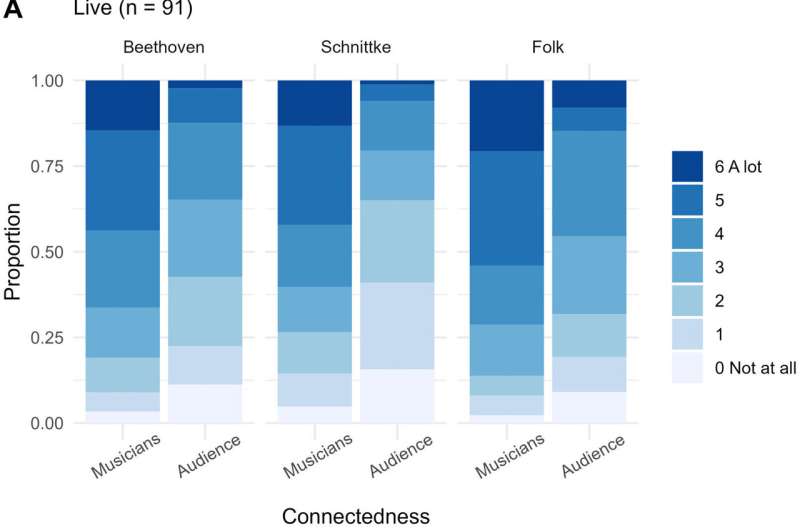This article has been reviewed according to Science X's editorial process and policies. Editors have highlighted the following attributes while ensuring the content's credibility:
fact-checked
peer-reviewed publication
trusted source
proofread
The miraculous effect of music: Concerts bind people together

Why does music exist? Some researchers believe that music is so widespread across human cultures because it brings people together. The theory is that during evolution, human groups who were musical worked better together, and therefore music may have offered an advantage for survival.
This theory is supported by research published in 2020 that suggests that moving together makes people like and trust each other more and cooperate better.
Researcher Dana Swarbrick wanted to investigate the topic further. In several studies, she has examined audience experiences and behavior at concerts. She recently completed a doctoral thesis at the RITMO Center for Interdisciplinary Research on Rhythm, Time and Motion, University of Oslo. "My research suggests that live concerts are indeed venues for social bonding," she says.
On Friday 1 December, Dana Swarbrick will defend her dissertation "Being in Concert: Audience Emotion, Motion, and Social Connectedness."
The experiences of the audience
In a study published in the journal Music & Science, Swarbrick and a colleague examined how the audience experienced a concert by The Danish String Quartet. Of the study participants, 91 sat in the audience, and 32 of them followed the concert as it was streamed live.
After each piece of music, the audience's experiences were measured using short surveys. They were asked whether they felt connected to the musicians and the audience, and about the intensity of their emotions of awe and feeling moved.
The audience's own smart phones were hung on their chests and used to measure their behavior by recording their movement.
Movement provides a sense of belonging
Whether they felt moved or in awe when they heard the music was purely about the piece of music being played, not about what people around them were doing or whether they were sitting in the hall or watching the concert livestream.
However, when it came to connectedness, the listening context and behavior of the other audience members were important:
"We saw that the audience in the auditorium felt more connected to the other audience members than those who followed the concert livestream. However, both groups felt equally connected to the musicians performing the concert," Swarbrick says.
Participants sitting in the auditorium expressed a stronger sense of connection with other audience members during the musical pieces where they moved in expected ways to the music. This was true regardless of whether they moved a lot, as they did during folk music, or whether they sat very still, as when the Beethoven and Schnittke pieces were performed.
Sitting still is also a response
"Our measurements suggest that classical concert audiences adapt to the music and environment around them, and in fact, sitting very still is how they show that they are engaged. This creates as much cohesion as when you are part of a group that moves a lot," Swarbrick says.
The more still the audience sat in response to what was happening in the classical music pieces, the stronger the connection the audience members felt to each other.
"The findings suggest that it is precisely the act of moving as the music suggests, that is, adapting to the genre and cooperating musically, that creates a sense of belonging."
Digital concerts can also provide a sense of belonging
Swarbrick started working on her Ph.D. six -months before COVID-19 struck. As a result, she also studied concerts that were streamed live on YouTube, Zoom, as well as concerts presented in virtual reality (VR).
Within the new field of "pandemusicology," she examined differences between livestreamed concerts and concerts that were pre-recorded. While live-streamed concerts provided a stronger sense of connection with the outside world than the recorded concerts, there was no difference in how moved the participants were by the music.
In another study, Swarbrick and colleagues found that participants who wore VR headsets reported a stronger sense of being physically present, and more connection with the artist, than those who followed the concert through a regular livestream on YouTube.
Overall, however, artists were able to achieve a good connection with the audience both when the audience were present and when they watched concerts digitally.
Physical presence provides the best musical experience
"Even though we can now attend concerts physically again, there are still streamed concerts. While physical concerts are more likely to provide a sense of connection with the audience, it seems that artists can still use digital concerts to connect with audiences around the world," Swarbrick says.
Still, concert experiences where you are physically present are in a class of their own, she points out.
"These concerts seem to create the strongest bonds between people. Our studies also suggest that the physical concert experiences more often give us a feeling of absorption in the music, and the best musical experience."
Swarbrick believes that there is a need for more research in this field.
"Is it the case, for example, that concerts can create a sense of belonging even among people who come from very different backgrounds or walks of life? We do not know yet, and I look forward to investigating this further," she says.
More information: Dana Swarbrick et al, Collectively Classical: Connectedness, Awe, Feeling Moved, and Motion at a Live and Livestreamed Concert, Music & Science (2023). DOI: 10.1177/20592043231207595
Journal information: Music & Science
Provided by University of Oslo




















